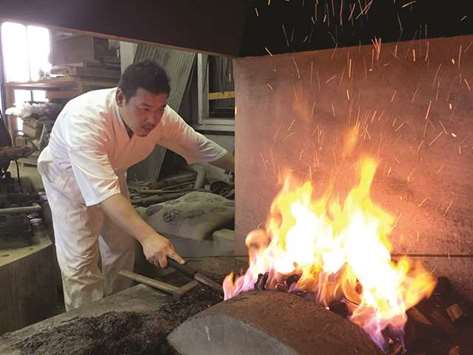Fusahiro Shimojima pulls a glowing red blade from the fire and hammers the long sword with a burst of sparks. Beads of sweat drip down his brow as he adds the final touches to weeks of work.
These subtle alterations are “thinner than a hair” and invisible to the untrained eye, the Japanese master craftsman says as he holds up the shimmering blade for closer inspection.
It is this quest for perfection that puts him and a few other learned Japanese swordsmiths in an elite category in the production of edged weapons.
“I am still sad when I hand over a sword to a customer – it must be like when your daughter marries,” says 43-year-old Shimojima, who lives with his wife beside his workshop, located in fields in a bleak Tokyo suburb because of the hammering noise.
He is a younger face among the around 200 licensed members of Japan’s Swordsmith Association, all dedicated to a thousand-year tradition that boomed in the Samurai era, but is now in danger of being forgotten.
One reason for their dying art is that swords are today officially regarded as dangerous weapons, falling together with firearms under Japan’s Weapons Protection Act.
This places stringent controls on the production of swords, and Shimojima needs a state permit for each one made to order. He may make a maximum of two a month, and finished items are checked and registered before he is allowed to sell them.
While the Japanese “nihontou” sword is mainly associated with dynastic battle depictions or the Second World War, few people know of its true origins, Shimojima laments.
It is not primarily a weapon, but an “omamori”, a kind of lucky charm that protects its owner and sharpens his willpower and sense of responsibility.
“Originally, a Japanese sword was dedicated to the deities,” says Shimojima. This was to guard you in both life and in death: A sword was also laid on the deceased until cremation to keep evil spirits away from the body.
In the Samurai period, brides wore a wedding kimono with a short sword to protect them after leaving their parents’ house. Then they could take their own lives in case of war and the husband’s death, and avoid being taken by the enemy. Swords were solemnly handed down family generations. But most of this legacy has been forgotten today.
Today, it’s an arduous career path for those who want to preserve the traditions and fashion swords.
“You have to study for at least five years with a licensed sword master,” says Shimojima. At age 18 he began a long apprenticeship living with his teacher, who he says cared for him like a son.
In the final year, an apprentice must pass a kind of state examination and forge a short sword before the Ministry of Culture grants the swordmaker’s licence. But before you can set up a business yourself, it is customary to offer your teacher one to five more years of work in gratitude for the apprenticeship.
While many of Shimojima’s peers must do other work to survive, he says he makes a decent living on the back of his hard-earned reputation for excellence.
His swords are recognisable in their proportions and the wavy “hamon” patterns on the blade that result from the elaborate kneading of the metal, says Shimojima proudly.
As for his clientele, elderly customers want traditional swords for their children or grandchildren. The swords are also popular among martial artists and collectors, and as corporate gifts.
None of this precision and beauty comes cheaply. Shimojima charges around three million yen (27,000 US dollars) for a long Japanese sword that takes two to three months to make.
At most, he produces six swords a year. Costs include the precious Tamahagane steel, special coal, and scabbards made by other masters, which leaves him just under two million yen.
It’s not about the money, Shimojima reminds, but preserving something unique to Japanese culture. As he says, parting with his creations is painful. The master still fondly remembers the first sword he made after graduation, which used to lay with him in bed every night until he found a buyer. -DPA

DEDICATED: Japanese swordsmith Fusahiro Shimojima has dedicated his life to a thousand-year tradition that boomed in the Samurai era, but is now in danger of being forgotten.
